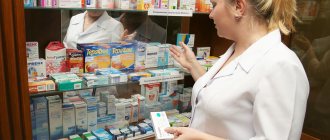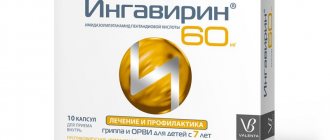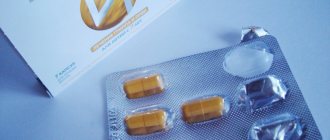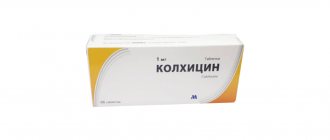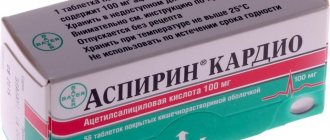When should you use the medication?
The drug is recommended to combat viral infections. It is recommended to prescribe the medication when rotavirus enters the digestive tract. In this case, Arbidol is used as part of the main treatment. It is acceptable to use the drug to eliminate herpetic eruptions (herpes simplex).
The drug is indicated after surgery. This helps prevent complications and improve overall immunity.
The drug is indicated as a systemic antiviral agent. It is taken simultaneously with symptomatic therapy (medicines for fever, cough and other drugs).
Arbidol for adults
You can drink Arbidol for preventive purposes or during the treatment of viral diseases. To prevent the occurrence of respiratory pathology, 200 mg is indicated twice a week for 21 days.
If you have had contact with respiratory patients, you need to drink 200 mg once a day. The duration of preventive measures should be up to 2 weeks.
Therapy for viral diseases:
- Uncomplicated course - 200 mg four times a day (intervals between doses - 6 hours), course therapy lasts 5 days;
- Complicated course (inflammation of the lungs, bronchi, otitis media and others) - adults, 200 mg four times a day for 5 days; then take 200 mg once a day for 1 month.
To prevent respiratory failure (RF), drink 200 mg once a day. For the treatment of DN, 200 mg is indicated twice a day for 8-10 days.
When relieving symptoms of chronic bronchitis or herpetic infection, you need to drink Arbidol 200 mg four times a day. Course therapy lasts 5-7 days. Then the dosage is reduced to 200 mg twice a day. Maintenance therapy lasts 1 month.
To prevent postoperative complications, it is recommended to drink 200 mg per day. The drug is started to be taken 2 days before surgery, and is also taken 2.5 days after surgery.
Attention! You should drink 200 mg once, the maximum amount is 800 mg per day.
Arbidol for children
A suspension is recommended for children. It is produced in the form of a powder substance. To prepare the suspension, pour 30 ml of boiled water (18-22 °C) into a bottle with powder. After dilution, you need to close the container and shake the bottle vigorously so that the powder substance dissolves.
Attention!!! Hot liquid should not be poured into the bottle, as this will affect the effectiveness of the medicine. Very cold water does not dissolve the powder substance well.
After the first dilution and shaking, add boiled liquid to the mark (volume 100 ml). Shake the container again and close the lid.
The prepared liquid should be stored for no more than 10 days. The bottle should be shaken before use.
Single dosages of the finished suspension:
- 2-6 years - 10 ml (50 mg),
- 6-12 years - 20 ml (100 mg),
- over 12 years old - 40 ml (200 mg).
Frequency of taking a single dosage
| State | Frequency of use |
| prevention of respiratory diseases | twice a week for 21 days |
| upon contact with an infected person | once a day for 2 weeks |
| treatment of viral respiratory tract infections | four times a day for 5 days |
| rotavirus infection | 4 times a day, the course of therapy is 5 days |
Treatment with the drug should be started no later than 3 days from the onset of the disease.
Arbidol for children
Arbidol suspension - instructions for use for children
2+ Where to buy
A homogeneous suspension of white or white with a yellowish or creamy tint of color with a characteristic fruity odor.
- Treatment:
10 ml x 4 times a day, 5 days - Post-exposure prophylaxis:
10 ml x 1 time per day, 10–14 days - Seasonal prophylaxis:
10 ml x 2 times a week, 3 weeks
Active substance:
Umifenovir (umifenovir hydrochloride monohydrate – 25.88 mg), (in terms of umifenovir hydrochloride – 25.00 mg).
Trade name of the drug:
Arbidol®
International nonproprietary name:
umifenovir
Dosage form:
powder for the preparation of suspension for oral administration.
Composition per 5 ml
active substance:
umifenovir (umifenovir hydrochloride monohydrate – 25.88 mg), (in terms of umifenovir hydrochloride – 25.00 mg);
excipients:
sodium chloride – 26.85 mg, maltodextrin (Kleptose Linecaps) – 750.00 mg, sucrose (sugar) – 840.42 mg, colloidal silicon dioxide (Aerosil) – 24, 60 mg, titanium dioxide – 25.00 mg, pregelatinized starch (type PA5PH) – 129.50 mg, sodium benzoate – 9.25 mg, banana flavor – 12.40 mg, cherry flavor – 6.10 mg.
Description:
granular powder of white or almost white color with a characteristic fruity odor.
Description of the prepared suspension:
a homogeneous suspension of white or white with a yellowish or creamy tint of color with a characteristic fruity odor.
Pharmacotherapeutic group:
antiviral agent.
ATX Code:
[J05AX13]
Pharmacological properties
Pharmacodynamics
Antiviral agent. Specifically suppresses in vitro influenza viruses A and B (Influenzavirus A, B), including highly pathogenic subtypes A(H1N1)pdm09 and A(H5N1), as well as other viruses - causative agents of acute respiratory viral infections (ARVI) (coronavirus (Сoronavirus) associated with severe acute respiratory syndrome (SARS), rhinovirus (Rhinovirus), adenovirus (Adenovirus), respiratory syncytial virus (Pneumovirus) and parainfluenza virus (Paramyxovirus)). According to the mechanism of antiviral action, it belongs to fusion inhibitors, interacts with the hemagglutinin of the virus and prevents the fusion of the lipid membrane of the virus and cell membranes. It has interferon-inducing activity - in a study on mice, the induction of interferons was noted after 16 hours, and high titers of interferons remained in the blood up to 48 hours after administration. Stimulates cellular and humoral immune responses: increases the number of lymphocytes in the blood, especially T-cells (CD3), increases the number of T-helpers (CD4) without affecting the level of T-suppressors (CD8), normalizes the immunoregulatory index, stimulates the phagocytic function of macrophages and increases the number of natural killer (NK) cells.
Therapeutic effectiveness for viral infections is manifested in a decrease in the duration and severity of the disease and its main symptoms, as well as in a decrease in the incidence of complications associated with viral infection and exacerbations of chronic bacterial diseases.
In the treatment of influenza or ARVI in adult patients, a clinical study showed that the effect of the drug Arbidol® in adult patients is most pronounced in the acute period of the disease and is manifested by a reduction in the time for resolution of symptoms of the disease, a decrease in the severity of manifestations of the disease and a reduction in the time for elimination of the virus.
Therapy with Arbidol® leads to a higher frequency of relief of symptoms of the disease on the third day of therapy compared to placebo - 60 hours after the start of therapy, the resolution of all symptoms of laboratory-confirmed influenza is more than 5 times higher than the same indicator in the placebo group.
A significant effect of the drug Arbidol® on the rate of elimination of the influenza virus was established, which, in particular, was manifested by a decrease in the frequency of detection of viral RNA on the 4th day. Refers to low-toxic drugs (LD50 > 4 g/kg). Does not have any negative effects on the human body when administered orally in recommended doses.
Pharmacokinetics
Quickly absorbed and distributed throughout organs and tissues. The maximum concentration in blood plasma when taking the drug at a dose of 200 mg of umifenovir is achieved after 1 hour, the volume of distribution (Vd) is 1432 l. Metabolized in the liver. The half-life averages 11 hours. About 40% is excreted unchanged, mainly in the bile (38.9%) and in small amounts in the kidneys (0.12%). During the first day, 90% of the administered dose is eliminated.
Indications for use
- prevention and treatment of influenza A and B, other acute respiratory viral infections in children over 2 years of age and adults;
- complex therapy of acute intestinal infections of rotavirus etiology in children over 2 years of age.
Contraindications
- Hypersensitivity to umifenovir or any component of the drug.
- Age up to 2 years. First trimester of pregnancy. Breast-feeding.
- Sucrase/isomaltase deficiency, fructose intolerance, glucose-galactose malabsorption.
- Carefully
- Second and third trimesters of pregnancy.
- Use during pregnancy and breastfeeding
In animal studies, no harmful effects on pregnancy, embryonic and fetal development, labor or postnatal development were identified. The use of Arbidol® in the first trimester of pregnancy is contraindicated. In the second and third trimester of pregnancy, Arbidol® can only be used for the treatment and prevention of influenza and if the expected benefit to the mother outweighs the potential risk to the fetus. The benefit/risk ratio is determined by the attending physician. It is not known whether Arbidol® passes into breast milk in women during lactation. If it is necessary to use the drug Arbidol®, you should stop breastfeeding.
Directions for use and doses
Inside, before meals.
Preparation of the suspension.
Add 30 ml (or approximately 2/3 of the bottle volume) of boiled water and cooled to room temperature to the bottle containing the powder. Close the bottle with a lid, turn it upside down and shake thoroughly until a homogeneous suspension is obtained. Add boiled and cooled water to a volume of 100 ml (up to the mark on the bottle) and shake again. Before each dose, shake the contents of the bottle thoroughly until a homogeneous suspension is obtained. Measure a single dose using the included measuring spoon.
Single dose of the drug (depending on age):
| Age | Single dose, ml suspension (mg umifenovir) |
| from 2 to 6 years | 10 ml (50 mg) |
| from 6 to 12 years | 20 ml (100 mg) |
| over 12 years old and adults | 40 ml (200 mg) |
Dosage regimen (depending on age):
| Indication | Dosage regimen |
| In children from 2 years of age and adults: | |
| Nonspecific prevention during an epidemic of influenza and other acute respiratory viral infections | in a single dose 2 times a week for 3 weeks. |
| Nonspecific prophylaxis in direct contact with patients with influenza and other acute respiratory viral infections | in a single dose 1 time per day for 10-14 days. |
| Treatment of influenza and other acute respiratory viral infections | in a single dose 4 times a day (every 6 hours) for 5 days. |
| In children from 2 years of age: | |
| Complex therapy of acute intestinal infections of rotavirus etiology | in a single dose 4 times a day (every 6 hours) for 5 days. |
Use the drug only according to the indications, method of administration and in the doses indicated in the instructions.
The drug should be taken from the moment the first symptoms of influenza and other acute respiratory viral infections appear, preferably no later than 3 days from the onset of the disease.
If, after using the drug Arbidol® for three days in the treatment of influenza and other acute respiratory viral infections, the severity of the symptoms of the disease, including high temperature (38 ° C or more), then you must consult a doctor to assess the validity of taking the drug.
When treating influenza and ARVI, concomitant symptomatic therapy is possible, including taking antipyretic drugs, mucolytics and local vasoconstrictors.
Side effect
The drug Arbidol® is a low-toxic drug and is usually well tolerated.
Side effects are rare, usually mild or moderate and transient.
The frequency of adverse drug reactions is determined in accordance with the WHO classification: very often (with a frequency of more than 1/10), often (with a frequency of at least 1/100, but less than 1/10), infrequently (with a frequency of at least 1/1000, but less than 1/100), rare (with a frequency of at least 1/10,000, but less than 1/1000), very rare (with a frequency of less than 1/10,000), frequency unknown (cannot be determined from the available data).
Immune system disorders: rarely - allergic reactions - itching, rash, angioedema, urticaria; very rarely - anaphylactic reactions.
If any of the side effects indicated in the instructions get worse, or you notice any other side effects not listed in the instructions, tell your doctor.
Overdose
Not marked.
Interaction with other drugs
When prescribed with other drugs, no negative effects were noted.
No special clinical studies have been conducted to study the interactions of the drug Arbidol® with other drugs.
There was no evidence of undesirable interactions with antipyretic, mucolytic and local vasoconstrictor drugs in a clinical study.
special instructions
When prescribing to patients with diabetes mellitus, as well as on a low-calorie diet, it is necessary to take into account that the suspension contains sucrose (0.8 g/5 ml or 0.06 XE/5 ml). It is necessary to follow the regimen and duration of taking the drug recommended in the instructions. If you miss taking one dose of the drug, the missed dose should be taken as early as possible and continue the course of taking the drug according to the started regimen.
If, after using the drug Arbidol® for three days in the treatment of influenza and other acute respiratory viral infections, the severity of the symptoms of the disease, including high temperature (38 ° C or more), then you must consult a doctor to assess the validity of taking the drug.
When calculating the amount of suspension required for a course of administration, it is necessary to take into account the shelf life of the prepared suspension, which is 10 days. For a course of treatment indicated for nonspecific prophylaxis during an epidemic of influenza and other acute respiratory viral infections in children from 2 to 6 years old, two bottles of the drug Arbidol® will be required.
Impact on the ability to drive vehicles and machinery
It does not exhibit central neurotropic activity and can be used in medical practice by people of various professions, incl. requiring increased attention and coordination of movements (transport drivers, operators, etc.).
Release form
Powder for the preparation of suspension for oral administration, 25 mg/5 ml. 37 g in bottles with a capacity of 125 ml (with a mark to the level of 100 ml) of dark (amber) glass. One bottle, along with instructions for use and a measuring spoon, is placed in a cardboard pack.
Storage conditions
Store at a temperature not exceeding 25 °C. Store the prepared suspension at a temperature not exceeding 8 °C (in the refrigerator). Do not freeze. Keep out of the reach of children.
Best before date
Powder for the preparation of a suspension for oral administration – 2 years. Prepared suspension – no more than 10 days. Do not use after the expiration date stated on the package.
Vacation conditions
Available without a prescription.
Marketing authorization holder/organization receiving consumer complaints
PJSC OTCPharm, Russia
123317, Moscow, st. Testovskaya, 10 Tel. Fax
305022, Russia, Kursk, st. 2nd Aggregatnaya, 1a/18 tel./fax
Pharmacodynamic properties
The mechanism of reproduction of viruses is different from that of bacteria. Viral particles penetrate through the mucous membranes of the respiratory tract into the blood. The pathogen seeks to enter the host cell. This is necessary for the synthesis of new viral particles.
The microorganism penetrates the cell and uses the patient’s DNA to form the virion genome. New microbes enter the bloodstream and spread throughout the body. The cell that was used to create new virions dies.
Umifenovir, which is the active component of the drug, has an antiviral effect on the body. The substance prevents the viral particle from merging with the host cell. Because of this, the virus cannot penetrate into the cell.
The drug prevents the virus from multiplying. The pathogen is not able to continue its life cycle, therefore it is present in the circulatory system for a long time. The protective cells have time to recognize and destroy dangerous microorganisms.
The medication also enhances immune defense. While taking medication:
- The number of lymphocyte cells increases;
- The function of macrophages that capture harmful microbes is stimulated;
- The number of immune cells that detect the presence of foreign microorganisms increases.
When the drug Arbidol is used correctly, patients tolerate the disease more easily. The duration of the disease decreases. Symptoms: hyperthermia, muscle pain, nasal congestion, sore throat begins to subside already on the 3-4th day of therapy.
pharmachologic effect
Antiviral agent. Specifically inhibits in vitro viruses A and B (Influenza virus A, B), including highly pathogenic subtypes A(H1N1)pdm09 and A(H5N1), as well as other viruses that cause acute respiratory viral infections (coronavirus associated with severe acute respiratory syndrome ( SARS), rhinovirus (Rhinovirus), adenovirus (Adenovirus), respiratory syncytial virus (Pneumovirus) and parainfluenza virus (Paramyxovirus). According to the mechanism of antiviral action, it belongs to fusion inhibitors, interacts with the hemagglutinin of the virus and prevents the fusion of the lipid membrane of the virus and cell membranes. It has interferon-inducing activity - in a study on mice, the induction of interferons was noted after 16 hours, and high titers of interferons remained in the blood up to 48 hours after administration. Stimulates cellular and humoral immune responses: increases the number of lymphocytes in the blood, especially T-cells (CD3), increases the number of T-helpers (CD4) without affecting the level of T-suppressors (CD8), normalizes the immunoregulatory index, stimulates the phagocytic function of macrophages and increases the number of natural killer (NK) cells.
Therapeutic effectiveness for viral infections is manifested in a decrease in the duration and severity of the disease and its main symptoms, as well as in a decrease in the incidence of complications associated with viral infection and exacerbations of chronic bacterial diseases.
Refers to low-toxic drugs (LD50>4 g/kg). Does not have any negative effects on the human body when administered orally in recommended doses.
Pharmacokinetics
Suction and distribution
Quickly absorbed and distributed throughout organs and tissues. Cmax in blood plasma when taking the drug at a dose of 200 mg of umifenovir is achieved after 1 hour, Vd - 1432 l.
Metabolism and excretion
Metabolized in the liver. T1/2 averages 11 hours. About 40% is excreted unchanged, mainly with bile (38.9%) and, in small quantities, by the kidneys (0.12%). During the first day, 90% of the administered dose is eliminated.
Pharmacodynamics
Active against influenza viruses A and B. It has a long-term protective effect, reduces symptoms of intoxication, the severity of catarrhal symptoms, shortens the febrile period and the overall duration of the disease. Prevents the development of post-influenza complications, reduces the frequency of exacerbations of chronic diseases, and normalizes immunological parameters.
Is it permissible during COVID-19?
Umifenovir is recommended for use both for the treatment of coronavirus infection and for the prevention of infection with Covid-19. As a preventive measure, the drug is ideal because it prevents the virus from entering cells, even if there has been contact with a sick person. Coronavirus can be present in the blood for up to 2 weeks or more without penetrating into cells. This explains the long incubation period (asymptomatic). For preventive purposes, it is recommended to take Arbidol for 2 weeks, which will prevent the virus from entering cells and its further reproduction.
It makes sense to prescribe the drug for the treatment of coronavirus infection, as it stops further reproduction of viruses. The medicine relieves symptoms and prevents complications. Arbidol copes well with mild forms of COVID-19.
Is it possible to take Arbidol during pregnancy and lactation?
Arbidol during pregnancy should be used only as prescribed by a doctor. The drug is prohibited during the first 3 months of pregnancy, since the medicine has not been studied in women in this group.
It is permissible to use the medication for the prevention and treatment of acute respiratory viral infections in the 2nd and 3rd trimester if the benefit to the patient outweighs the possible negative effects on the embryo.
There is no data on the ability of the drug to penetrate the secretions of the mammary glands. If the medication is prescribed by a doctor, breastfeeding should be suspended for the entire period of therapy. During treatment, you need to pump regularly to maintain lactation.
Is Arbidol suitable for breastfeeding women?
Arbidol is a low-toxic medicine. When using it, side effects are extremely rarely observed. Unfortunately, no experiments have been conducted regarding the effect of the drug on breastfeeding. The instructions note that it is unknown how much of the substance passes into breast milk. Therefore, it is more advisable to interrupt breastfeeding during treatment.
But still, some doctors prescribe the drug during lactation, until a negative effect on the child has been recorded.
Special conditions
If the drug is prescribed as a suspension to patients with diabetes, the sucrose that is present in the dosage form should be taken into account.
During therapy, you must strictly follow the instructions for use. If 1 dose was missed, it should be taken as soon as possible. And then the medicine is taken according to the schedule. It is not advisable to miss taking your medication at the scheduled time. Skipping a dosage reduces the concentration of the drug in the blood, which affects the effectiveness of therapy.
Attention! If symptoms of acute respiratory viral infection or flu do not subside within 3 days, you should consult a doctor for examination and treatment adjustment.
Precautionary measures
Use in children
The use of Arpetol in children under 6 years of age may be limited due to the possible lack of ability to swallow tablets at this age. If you do not have the ability to swallow tablets, Arpetol is recommended to be used under the supervision of a physician due to the risk of tablet aspiration. This risk is associated with the immaturity of the swallowing reflex, which can occur before the age of 6 years.
Features of use in elderly patients
No dose adjustment is required when using the drug in elderly patients.
Features of use in patients with impaired liver and kidney function
The pharmacokinetics and safety of Arpetol in patients with impaired liver and kidney function have not been studied.
The drug contains lactose, so it should not be taken by patients with rare hereditary forms of galactose intolerance, Lapp lactose deficiency or glucose-galactose malabsorption syndrome.
Restrictions on use
The medicine is not recommended if you have an allergic reaction to umifenovir. The drug should not be prescribed to patients under 2 years of age. It is prohibited to use an antiviral agent during pregnancy in the first trimester. The drug is not recommended during lactation.
You should not take the medication if:
- Lactase deficiency;
- Malabsorption syndrome.
Take the medication carefully in the 2nd and 3rd trimesters of pregnancy.
What kind of medicine is Arbidol?
The drug Arbidol is a fairly effective antiviral agent.
The medication specifically affects viruses and provokes the production of interferon in the human body.
The active component of Arbidol helps stimulate the cellular, humoral reactions of the immune system, thereby increasing resistance to viral pathologies.
Due to the mechanism of action on the body, the medicine can be called a fusion inhibitor. Taking a pharmaceutical product helps:
- reducing the incidence of complications associated with exposure to viruses
- reduces the risk of exacerbation of chronic bacterial diseases
Analogues of the drug Arbidol
The medicine has structural and non-structural analogues that are not inferior in effectiveness. Similar drugs include:
- Viferon;
- Grippferon;
- Kagocel;
- Anaferon;
- Umifenovir;
- Arpeflu.
Structural analogues include Arpeflu, Umifenovir. They have the same active ingredient: umifenovir. The mechanism of action of drugs is similar to Arbidol. The drugs are produced in the form of tablets of 50 mg.
Non-structural analogues include Viferon, Kagocel, Anaferon, Grippferon.
Viferon
Viferon is an effective analogue. It is available in the form of rectal suppositories. There is also an ointment and gel form for topical use. The drug belongs to the group of cytokines. Contains interferon alpha-2b. Due to the fact that interferons enter the body from the outside, the effect of therapy is noticeable within 1-3 hours after use. The product is suitable for influenza, rotavirus, adenovirus, respiratory syncytial, herpes and other infections.
The medication can be used in children from birth, including premature babies. The medicine is suitable for lactating and pregnant women at any stage of gestation.
Grippferon
Another analogue is Grippferon. It is produced in the form of nasal drops and spray. The drug is used topically. The medicine contains interferon alpha-2b. It is allowed for children, pregnant and lactating patients.
Kagocel
Kagocel is an interferon inducer. The medicine increases the formation of the patient’s own protective antibodies. The medicine is produced in the form of tablets. The drug is approved from 3 years of age. It is prohibited to use it during pregnancy and lactation.
Anaferon
Anaferon is produced in the form of tablets and drops. The active component of the drug is antibodies to human interferon gamma. The drug enhances the functioning of immune mechanisms. The medicine can be taken by children from 1 month of age. During pregnancy and breastfeeding, the drug is prescribed only by a doctor. The medicine is indicated for herpetic rashes, acute respiratory viral infections, and influenza.
Arbidol today is one of the most frequently purchased drugs. The medication is suitable for both adults and children. It is acceptable to use during pregnancy from the 2nd trimester. The medicine is non-toxic and does not damage the kidneys and liver. Umifenovir is ideal for the treatment of coronavirus infection, influenza, herpes and other conditions. It can only be used as prescribed by a doctor, despite the availability in pharmacies.
Release form, composition
Arpetol is available in white coated tablets with a biconvex surface. Each tablet contains: umifenovir hydrochloride – 50 mg or 100 mg; as well as excipients: povidone (K 17), microcrystalline cellulose, modified corn starch (Starch 1500), magnesium stearate, colloidal anhydrous silicon dioxide, lactose monohydrate, opadry II white (polyvinyl alcohol, titanium dioxide, polyethylene glycol, talc).
In pharmacies, arpetol is sold in blister packs of 10, 15 or 20 tablets (a cardboard pack can contain from 10 to 40 tablets).
